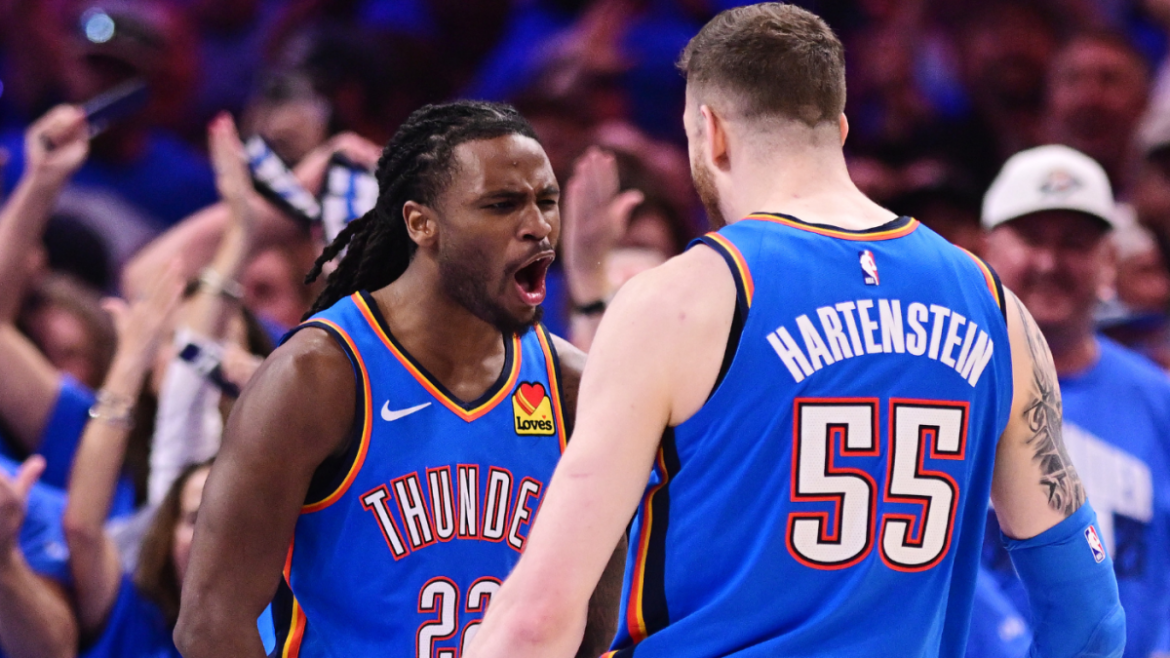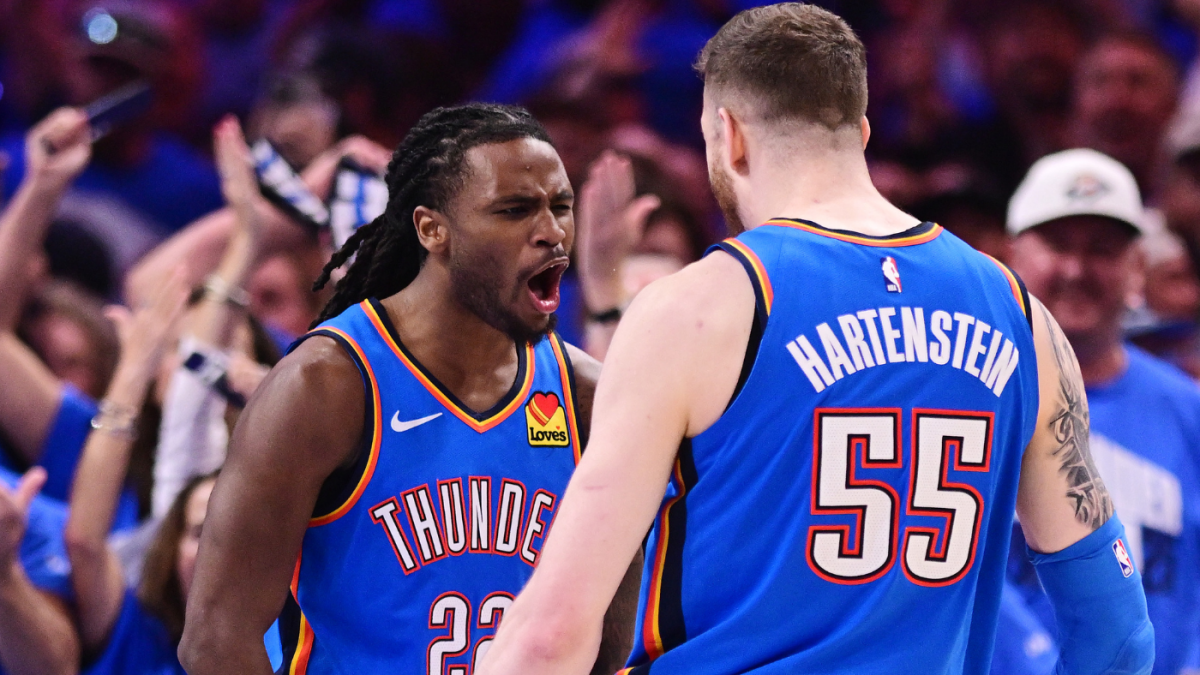The Oklahoma City Thunder’s lineup adjustments in the 2025 NBA Finals against the Indiana Pacers have become a central storyline, sparking debate about optimal strategies to maximize their championship aspirations. After adhering to a consistent starting five—featuring Isaiah Hartenstein as the starting center—throughout their playoff run leading up to the Finals, the Thunder’s coaching staff made a surprising decision to bench Hartenstein in favor of backup guard Cason Wallace for Game 1. This report examines the rationale behind this bold move, its implications for the Thunder’s gameplay, and the considerations for adjustments in Game 2 and beyond.
The Context of Change: A Departure from Consistency
Throughout the 2024-2025 season and the Western Conference playoffs, the Thunder’s starting lineup was notably stable. Isaiah Hartenstein, a key presence at center, started 53 of 57 regular-season games and all playoff contests, contributing with solid rim protection, rebounding, and facilitating offense in the paint. Alongside him, core players like Shai Gilgeous-Alexander, Lu Dort, Jalen Williams, and Chet Holmgren provided a balanced mix of scoring, defense, and versatility.
Entering the NBA Finals against the Indiana Pacers, this entrenched lineup was suddenly altered. Coach Mark Daigneault opted for a smaller, more agile starting five by replacing Hartenstein with Cason Wallace, a young defensive guard known for quickness and perimeter pressure. This strategic shift aimed to counter the Pacers’ speed and defensive intensity, particularly their penchant for wearing down opponents through pressure defense.
Evaluating the Decision: Why Bench Hartenstein?
The decision to bench Hartenstein was driven by tactical considerations related to the Pacers’ style of play. Indiana is renowned for quickness, rapid ball movement, and pressure defense, forcing opponents into turnovers and controlling tempo. The Thunder, conversely, had to find a way to adapt by speeding up their own play and enhancing perimeter defense.
Cason Wallace’s insertion provided Oklahoma City with a defensive weapon to disrupt Indiana’s backcourt and help maintain pace. His agility facilitated better matchup control against the Pacers’ quicker guards, offering an edge in transition and the ability to exploit turnovers. This smaller lineup also aimed to improve floor spacing, allowing shooters like Gilgeous-Alexander and Williams to operate more freely.
However, this move came at the expense of interior size and physicality. Hartenstein’s impact on paint defense, offensive rebounding, and setting screens for inside-out offense was diminished. His presence helped anchor the defense and create second-chance opportunities, factors that proved crucial in earlier playoff rounds.
Game 1 Outcomes: A Mixed Bag of Results
The Thunder’s Game 1, played without their starting center, ended in a narrow 111-110 loss. Oklahoma City demonstrated excellent defensive effort, forcing 25 turnovers—the highest in any NBA Finals game this century—which revealed their ability to use pressure defense effectively.
Nevertheless, the trade-off was their paint protection and interior control. Without Hartenstein, the Thunder struggled to dominate the boards and control the paint as effectively, which the Pacers exploited during their comeback run. Chet Holmgren, the Thunder’s other frontcourt centerpiece, logged limited minutes, further reducing interior presence at critical junctures.
Offensively, some players excelled, such as Jalen Williams scoring 30 points and Hartenstein later posting a double-double when he entered as a substitute, highlighting his value. The close scoreline and late-game execution, including clutch shooting from Indiana’s Tyrese Haliburton, ultimately decided the contest.
Anticipating Game 2: Balancing Size and Speed
Following the loss, Coach Daigneault hinted at a potential return to the original lineup or at least a reconsideration of Hartenstein’s role in Game 2. The strategic question became: Should the Thunder embrace the smaller, speed-focused lineup or revert to the double-big formation that includes Hartenstein and Holmgren?
Arguments for reintroducing Hartenstein in the starting five include:
– Defensive Anchoring: Hartenstein’s rim protection could deter the Pacers’ inside scoring and reduce second-chance points.
– Rebounding Strength: Controlling the boards is critical in fast-paced finals matchups, and Hartenstein’s presence helps limit opponent possessions.
– Offensive Facilitation: His ability to “set the table” with screens, pick-and-rolls, and inside scoring creates offensive diversity.
On the other hand, maintaining Cason Wallace’s position offers benefits:
– Perimeter Defense: Wallace’s quickness can neutralize Pacers’ guards and create more transition opportunities.
– Increased Pace: Smaller lineups can enhance spacing and ball movement, vital against teams like Indiana who thrive on speed.
Strategic Considerations Moving Forward
To avoid falling into a 0-2 deficit in the series, the Thunder must find a way to capitalize on their ability to force turnovers while addressing paint dominance and rebounding. This highlights the need for a hybrid approach:
– Flexible Lineups: Employing staggered minutes where Hartenstein and Wallace both play significant roles, depending on game situations.
– Chet Holmgren’s Role: Increasing minutes for Holmgren to bolster interior defense and offense alongside Hartenstein might provide a physical presence capable of matching Indiana’s size differential.
– Adjusting Defensive Schemes: Combining aggressive perimeter defense with solid rim protection to mitigate Pacers’ scoring runs.
Conclusion: The Path to an Even Series
The Thunder’s decision to start Cason Wallace over Isaiah Hartenstein in Game 1 of the NBA Finals signaled a willingness to adapt tactically against a formidable Pacers team. Although the risk introduced challenges in the paint and on the boards, the move aimed to leverage defensive speed and perimeter pressure without sacrificing offensive flow.
Going into Game 2, the central question remains how Oklahoma City balances the benefits of speed with the necessity of size and inside presence. Integrating more Isaiah Hartenstein minutes, whether in the starting lineup or early in the game, seems a strategic necessity to fortify the paint and rebounding against Indiana’s pressure.
Ultimately, the Thunder’s ability to adjust their lineup dynamically and optimize player roles will be pivotal in evening the series and pushing for an NBA championship. The interplay between Hartenstein’s interior influence and Wallace’s perimeter agility embodies the broader strategic challenge facing modern teams: blending size and speed to outmatch versatile opponents.





